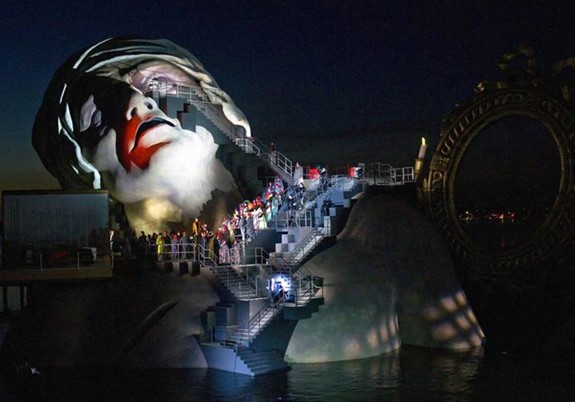André Chénier, poète français
André Chénier, French poet
(4).jpg)
Poésie : journée mondiale : La première Journée Mondiale de la Poésie a été organisée à Venise en 1988. L'objectif de cette journée est d’encourager la lecture, la rédaction, la publication et l'enseignement de la poésie dans le monde entier. Voici donc, un poète français que vous ne connaissez peut-être pas. Je l’ai choisi parce que dans quelques jours ce sera l’anniversaire de sa mort. Il était guillotiné pendant la Révolution française.
THE REAL ANDRÉ CHÉNIER André Chénier
Biography by Mario Hamlet-Metz
André Chénier, born in Constantinople on October 30, 1762, was the third son of Louis de Chénier, an officer at the French embassy; his mother was a Greek, Santi l'Homaka ("la belle Grecque"), famous for her beauty and wit. After spending most of his childhood in southern France with an aunt, André joined his mother in Paris, where she had settled in 1773. While still in his teens, he became a fervent admirer of everything related to the language and civilization of ancient Greece. His natural fever for knowledge was stimulated even more by the brilliant artists and intellectuals he met during his mother's weekly soirées.
His Levantine background and the luxury and refinement in which he was brought up made Chénier an attractive bon viveur who thoroughly enjoyed the easy nonchalance reigning in the Parisian salons - and boudoirs. At the same time there was in him the sensitive artist gifted with a rich inner life, one that allowed him to isolate himself from the troubled world around him and to take wing into the spheres of meditation and poetic inspiration. The only true poet of his time, he rediscovered Greek classic literature and gave it renewed beauty in his own powerful verses, conciliating antiquity and modern thought most naturally and restoring long-lost lyricism to French poetry.
Predictably, Chénier detested garrison life in Strasbourg, where the regiment he joined in 1782 as a gentleman-cadet was stationed, and after six months he was back in Paris writing feverishly for a couple of years, until he realized his was no time for poetry. He became a member of the Society of '89 (the moderate wing of the revolutionary party) and subsequently started his short career as a political journalist, fighting eloquently against anarchy, injustice and tyranny. After the imprisonment of Louis XVI he sensed that the defense of the principles of the Revolution within the framework of moderation, law and order was a utopian dram and, in bitter disillusionment, decided to withdraw from public life. He fled Paris for some time, but too fascinated by political events, he couldn't refrain from returning - a fatal decision.
On March 4, 1794, he was arrested by mistake while visiting friends in Passy and taken to police headquarters at the Luxembourg; officials didn't want to keep him, for there was no arrest warrant, but all the same sent him on to St. Lazare Prison, where he spent the last four and a half months of his life.
Originally a leper hospital, St. Lazare had become a prestigious correctional institution for "prodigal sons" as early as 1632. During the Revolution it became a political prison and was called "one of the guillotine's most plentiful pantries". There Chénier met, among others, the poet Jean-Antoine Roucher, who became his confidant; Louise de Laval-Montmorency, abbess of Montmartre (both mentioned in the opera Andrea Chénier); a Vergennes (possibly the son of the Count Gravier mentioned in Act III of the opera, who had died in 1787); J.B. Suvée, who painted his most famous portrait, and Aimée de Coigny, Duchess of Fleury, alias Citizeness Franquetot.
Chénier was at once attracted by this charming 23-year-old beauty, who became, after the already immortalized Lycoris and Fanny, his last muse, the one who inspired his best verses, those of "The Young Captive". This poem - which, along with all the others he wrote at St. Lazare, was concealed in a basket of soiled linen and sent beyond the prison walls to posterity - contributed immensely to the legend of Chénier and Aimée's tragic love affair, which, of course, never did occur in real life. In fact, this muse was hardly the angelic creature she appears to be in the poem, which actually may have been nothing more than an aesthetic reverie. Married at 16, Aimée had taken in the years that followed such famous lovers as the irresistible "beau" Lauzun, Lord Malmesbury and M. de Montrond. The last mentioned was imprisoned at St. Lazare with her and married her (Aimée's husband had died in exile) after they were set free - via a 100-louis bribe to the prison guard. In her memoirs there is no mention of Chénier, and it is very likely that she didn't even know she had been immortalized in verse.
On July 24, 1794, Chénier was taken before the Revolutionary Tribunal, where he was accused of writing against freedom in favour of tyranny (!), of participating in the scandalous conspiracy of prisons (a machination of the sinister public prosecutor Fouquier-Tinville) and of being an assistant to the disgraced General Dumouriez (here he was mistaken for his brother Sauveur Chénier, who had indeed fought under Dumouriez). The jury paid little attention to the charges and was fast in passing sentence: immediate death. Chénier and 37 other prisoners were then taken to the Conciergerie, where, on the eve of his execution, he wrote these moving verses, so similar in their essence to those Illica would write in his libretto ("Come un bel dì di maggio"):
As the sun's last flashing ray,
As the last cool breeze from the shore,
Cheer the close of a dying day,
Thus I strike my lyre once more.
As now by the scaffold I wait,
Each moment of time seems the last,
For the clock, like a finger of fate,
Points onward and onward fast.
A poet until his last minute, he stepped onto the dernière charrette (also called "Sanson's cart", as in Act II of the opera) with his friend Roucher, and they both started reciting verses from Racine's Andromaque on their way to the guillotine. Chénier the political martyr was executed on July 25 on Place de la Barrière Renversée (now Place de Vincennes) and is remembered as one of the last illustrious victims of the Reign of Terror, which ended only three days later with Robespierre's own death. (The most frequently used guillotine was on Place de la Révolution - previously Place Louis XV and now Place de la Concorde - but during the last days of the Terror there were so many victims that additional scaffolds had to be built.) Chénier the poet-martyr was discovered only in 1819, when Henri de Latouche edited his complete poems. He immediately became an idol of the young Romantics, who saw in him a forerunner of their movement. His life, especially the last years, inspired numerous works, including poems by such French authors as Victor Hugo and Alfred de Musset. But the most famous of them remains, of course, Giordano's opera Andrea Chénier.
For a little more of André Chénier's poetry Click here.

For a sampling of the opera : Luciano Pavarotti - Andrea Chenier Act Two
